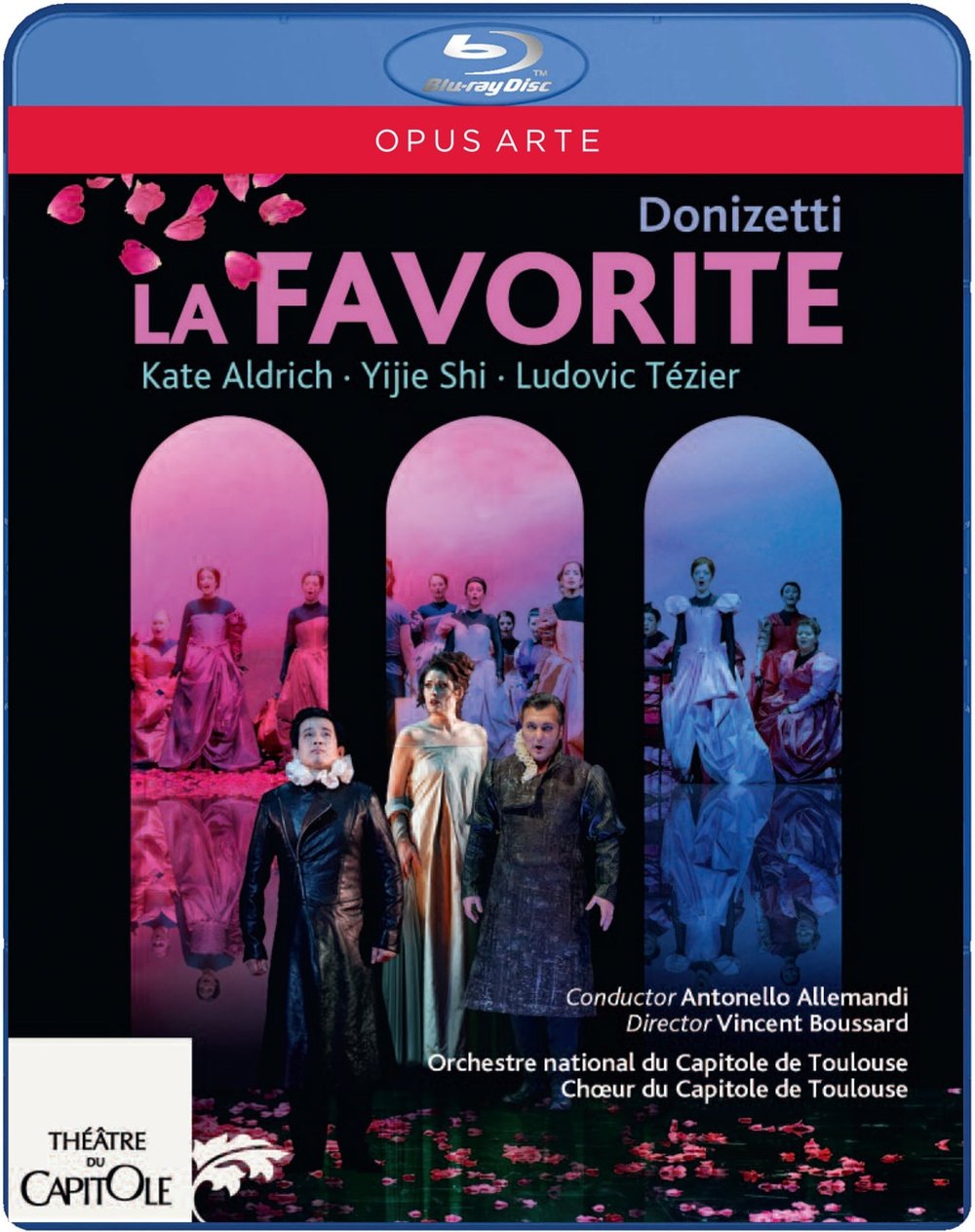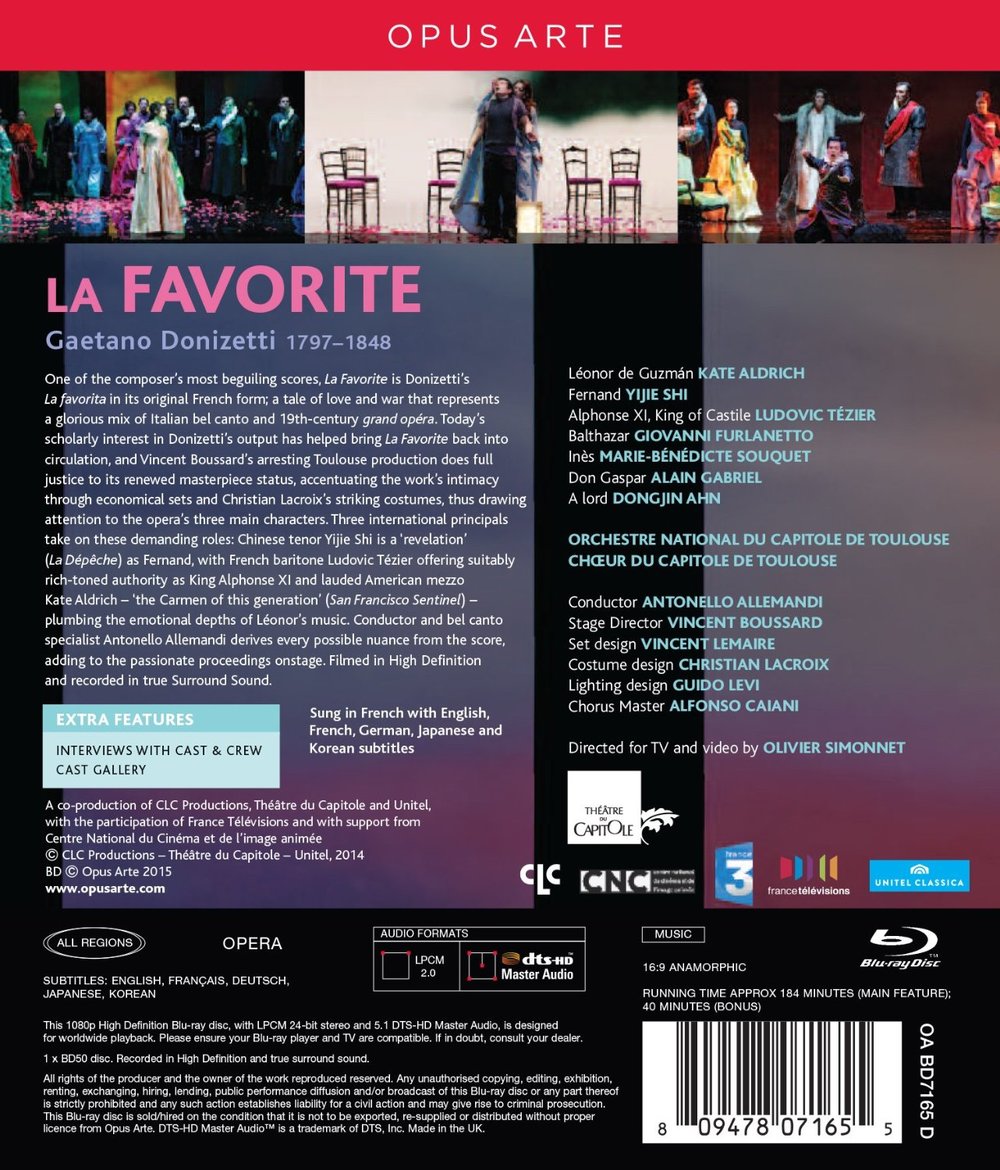

Donizetti La Favorite opera to a libretto by Alphonse Royer and Gustave Vaëz. Directed 2014 by Vincent Boussard at the Théâtre du Capitole de Toulouse. Stars Kate Aldrich (Léonor de Guzmán), Yijie Shi (Fernand), Ludovic Tézier (Alphonse XI, King of Castile), Giovanni Furlanetto (Balthazar), Marie-Bénédicte Souquet (Inès), Alain Gabriel (Don Gaspar), and Dongjin Ahn (A Lord). Extras: Éric Afergan, Margo Becz, Evelyne Capot, Joël Capot, Céline Chemin, Sylvie Clanet, Yannick Dubuisson, Valérie Habermann, Patrick Joseph, Antonio Scarano, Joël Sitbon, and Corinne Vrignon. Antonello Allemandi conducts the Orchestre National du Capitole de Toulouse and the Choeur du Capitole de Toulouse (Chorus Master Alfonso Caiani). Set design by Vincent Lemaire; costume design by Christian Lacroix; lighting design by Guido Levi. Directed for TV by Olivier Simonnet. Audio Producer was Philippe Engel; TV Producer was Pierre Moitron; Executive Producers were Sabrina Azoulay and Jean-François Boyer. Sung in Italian. Released 2015, disc has 5.1 dts-HD Master Audio sound. Grade: A-
Let's start this review with a comment from Wonk John Aitken:
“The cast in this production of La Favorite is a fine one headed by Kate Aldrich as Léonor, the "favorite" of the title, Yijie Shi as Fernand, and Ludovic Tézier as Alphonse XI, King of Castile. There is much to enjoy here. The production has costumes by the renowned couture designer Christian Lacroix. He chooses very strong opposing colours for the ladies, lime green, red and pink, etc. The men are mostly in black. Overall the designs work well, although in the full glare of Blu-ray, some of the costumes look distinctly unfinished—perhaps this was meant! At any rate the production is fairly simple, sumptuous to look at, and directed in a very straightforward staging which helps the piece along.
Antonello Allemandi is in charge musically and he produces some wonderful playing from the orchestra. He clearly knows his Donizetti and steers a clear course which neither indulges nor spares the score its many felicities. Kate Aldrich and Ludovic Tézier are established artists of considerable talent who sing superbly throughout, but the icing on the cake is provided by Yijie Shi. Born in Shanghai, he subsequently spent time at the Pesaro Rossini Festival and it shows. He has a lovely even lyric tenor which is completely up to the demands of this difficult music and produces the performance of the evening as Fernand. He is certainly a singer to watch in the future. Smaller roles are somewhat unevenly taken. Marie-Bénédicte Souquet has charm as Inèz, but sadly I could not warm to the Balthazar of Giovanni Furlanetto, who gives a somewhat rough-edged performance. Ideally you need a more authoritative voice for this role. Overall though, and especially for the three principals, this is an excellent disc and will undoubtedly give anyone with a love of bel canto a splendid return for their money.”
Mike Ashman, writing in the June 2015 Gramophone (page 90) agrees with Aitken. But on the other hand, Patrick Dillon in the August 2015 Opera News (pages 56-57) says,
“Here's another silly production by Vincent Boussard . . . with Vincent Lemaire's cheap-looking sets . . . garishly lit by Guido Levi. . . that gives the cast the sinister look of the undead. And Christian Lacroix's costumes are simply godawful.”
So the spat is over designs. Let's jump right into screenshots! The first picture below is from the curtain call with the ladies standing straight looking like the colors in a new box of crayons. For maybe the only time in this production, a plain white light (I think) is used. In the rest of the screenshots that follow I think virtually every image is affected by some color of lighting:
In the early scene below we see one of several instances where green spotlight is used, this time with a reddish and purple background. Even more interesting is the bright, shining suitcase in the hand of our hero Fernand (Yijie Shi). Fernand saw a beautiful woman in church and is leaving the monastery to pursue her even though he doesn't know who she is. I think this might be a variation on Diogenes with his lamp looking for an honest man or for truth. Balthazar (Giovanni Furlanetto), the Father of the order, predicts the future:
Fernand travels by night to an island where he thinks his beloved might live. He's met by members of the court of King Alphonse XI in a wine-colored scene:
Here's more green with King Alphonse (Ludovic Tézier) speaking to a courtier about envy (which, in English-language tradition is green in color):
The costumes were designed by Christian Lacroix. I asked my wife about Lacroix. My wife is not an opera fan and doesn't know her Donizetti from her Ligeti. But she told me all about Lacroix. Based on this small, unscientific sample, I assert that Christian Lacroix enjoys more fame than all the rest of the working opera-costume designers in the world lumped together. We have other work by Lacroix in HDVDs. His designs for Jewels were very conservative (no doubt as required by the Balanchine Trust). Latroix has teamed up with director Boussand and set designer Lemaire in two other HDVDs: a cheerful Don Giovanni and the recent more radical I Capuleti e i Montecchi.
The costumes Lacroix designed for La Favorite are simple but distinctive and, I think you may agree, quite beautiful. The garments for the leading women are finished impeccably. But Aitken is right, the gowns for the women of the courtiers have distinctive flaws. For example, the gray gown for the red-headed lady below fits her well and is quite neat except for one pleat in the bodice that's left unfinished. The ladies in the background in coral and pink have similar dresses. Then further below is a lady with strings hanging out the back of her dress! This reminds of a girl I knew long ago who was pretty. She was in a car wreck and was left (even after plastic surgery) with a small scar above one eye. She was distraught about this until I told her the scar promoted her from pretty to gorgeous. It made her more interesting to gaze at with its vague suggestion of danger and past violence. And the lawyer got her enough in damages to pay for her college! Well, that's one theory for the Lacroix imperfections. Another would be that the director wanted to suggest that courtiers and their wives are defective people:
Alphonse XI really did have a mistress named Léonor. But there was no doubt about their loyalty to each other, and she bore him 10 children. In this opera, she is just "The Favorite." When she was sent by her father to Alphonse, she expected to marry promptly, but this didn't happen. Now she is restless at the same time that Alphonse is learning to appreciate her more:
Léonor was the woman Fernand saw in the church. Léonor sees the possibility of a true love with the mysterious young visitor who doesn't know who she is. In the next two pictures, Léonor greets the stranger and provides him with an appointment as a military officer. This gives him a chance to earn a place in court society through valor at arms. (This sounds just like Guillaume Tell, doesn't it?) Note also in the shots below the natural light, which lets us see the better the murky design on the back wall. The design is the shadow of a peacock, the royal bird in the court of Alphonse. And note also that the glowing suitcase is still at hand. How did Guido Levi light this glowing prop? My best guess is that the case was built with batteries and LEDs as an internal source of light. Or perhaps it was covered with hyper-reflective material.
The next 5 screen shots are from the last few minutes of Act 2, where things start to fall apart for Léonor. The King detects that Léonor has another love interest. At the same time, Balthazar appears with an order from the Pope to the King to cast out his mistress. In the general uproar the background colors change from blue and violet to red and gray, and all the colors on stage change accordingly:
Léonor appeals to the audience for mercy:
As we enter Act 3, Fernand has become a great general and saved the kingdom from the Moors. But the poor guy still hasn't figured out that his beautiful benefactress is the mistress of the King:
Fernand asks for the hand of Léonor. This solves several problems for Alphonse, and he consents. But Léonor is horrified. Fernand doesn't know the truth about her. How vile it would be . . . :
Léonor sends her confident Inès (Marie-Bénédicte Souquet) to explain things to Fernand:
She hopes Fernand will forgive her and then marry her anyway. But the main reason for including the picture below is that the glowing suitcase has suddenly reappeared on stage again. It seems to pop up each time we have someone trying to uncover the truth:
Here's more dramatic lighting as the King ennobles Fernand while the suitcase looks on (still in the lower left):
Before Inès can find Fernand and tell him who his sweetheart is, Inès is arrested and put in prison. The wedding takes place. Léonor thinks Fernand now knows about her past, but he's still in the dark. The courtiers gleefully hit him with the truth after the wedding, and he's completely surprised:
Fernand uses his sword to remove his wedding ring:
He renounces all his titles, throws back all the kingly gifts, and breaks his sword. Before the King can punish him for this outburst, Balthazar rushes Fernand back to the monastery:
Now Léonor is near death. She visits Fernand one last time to explain why she married him as she did. At first we see her in a Lacroix cocoon dress with a veil and no arms!
You don't see too many final opera scenes with the soprano behind a veil:
My last screenshot. Get the opera to see how this ends:
By this time I think you should be able to make up your own mind whether the designs of Boussard, Lemaire, Lacroik, and Levi are admirable or silly. This French language version of La Favorite was performed 692 times in Paris between 1840 and 1918 before it went out of style. Somehow the opera-lovers of that era were able to overlook the inane plot with a victorious general so naive that he didn't know his idol and benefactress was the notorious mistress to the King. Today we need something else to make up for the feeble plot and support the glorious bel canto music. My view would be that the strong and enticing modern designs partially fill the void. Stated differently: with the great music and interesting designs, you have enough to enjoy the show no matter how suspect the plot may be. Grade: I start with an " A+" for the music and production with a reduction to "A-" for the weak plot.
Here are a couple of good clips for this vibrant production:
OR





























